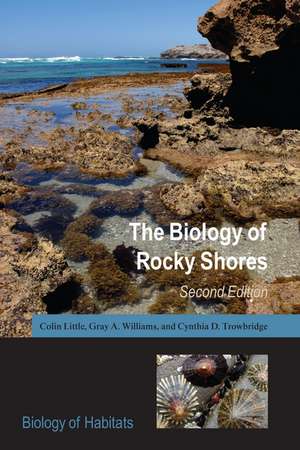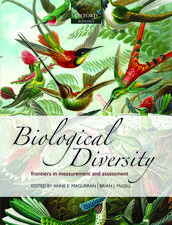The Biology of Rocky Shores
Autor Colin Little, Gray A. Williams, Cynthia D. Trowbridgeen Limba Engleză Paperback – 5 mar 2009
| Toate formatele și edițiile | Preț | Express |
|---|---|---|
| Paperback (1) | 304.01 lei 31-37 zile | |
| Oxford University Press – 5 mar 2009 | 304.01 lei 31-37 zile | |
| Hardback (1) | 690.55 lei 31-37 zile | |
| OUP OXFORD – 5 mar 2009 | 690.55 lei 31-37 zile |
Preț: 304.01 lei
Nou
Puncte Express: 456
Preț estimativ în valută:
58.18€ • 63.17$ • 48.87£
58.18€ • 63.17$ • 48.87£
Carte tipărită la comandă
Livrare economică 11-17 aprilie
Preluare comenzi: 021 569.72.76
Specificații
ISBN-13: 9780198564911
ISBN-10: 0198564910
Pagini: 372
Ilustrații: 95 line and 35 halftone illustrations
Dimensiuni: 156 x 233 x 20 mm
Greutate: 0.64 kg
Ediția:2 Rev ed.
Editura: Oxford University Press
Colecția OUP Oxford
Locul publicării:Oxford, United Kingdom
ISBN-10: 0198564910
Pagini: 372
Ilustrații: 95 line and 35 halftone illustrations
Dimensiuni: 156 x 233 x 20 mm
Greutate: 0.64 kg
Ediția:2 Rev ed.
Editura: Oxford University Press
Colecția OUP Oxford
Locul publicării:Oxford, United Kingdom
Recenzii
This volume is recommended reading for anyone interested in rocky shore ecology. Researchers will also find it useful as a reference, and its well-written, nontechnical style also makes it an excellent source of information for more general readers with an interest in their local shorelines; therefore, it will be a valuable addition to most public libraries. The writing is clear and flows well, making it a pleasure to read.
Overall, the book is a delightful piece of work, well documented, with more than 500 references. The text is easy to read and gives a straightforward synthesis of current scientific knowledge. Its conciseness, key-references and many diagrams, make it a goldmine for teachers of marine ecology.
Overall, the book is a delightful piece of work, well documented, with more than 500 references. The text is easy to read and gives a straightforward synthesis of current scientific knowledge. Its conciseness, key-references and many diagrams, make it a goldmine for teachers of marine ecology.
Notă biografică
Colin Little studied zoology at Cambridge University, and stayed on to do a Ph.D. on snail physiology. Then he migrated to Miami, USA, where he worked at the Institute of Marine Science, University of Miami, and first encountered the (at the time little-known) phylum Pogonophora. This provided his conversion to marine biology, and he returned to the University of Bristol, England and began to study the biology of the Severn Estuary as well as the brackish-water ecology of coastal lagoons. Running marine field courses and teaching estuarine and marine biology became major interests. He started to do research at Lough Hyne, Ireland, about 30 years ago, and there he began to concentrate on the biology of limpets and long-term intertidal monitoring. He is now retired, but continues these monitoring studies. Gray A. Williams spent many of his childhood summers messing around on the shores of South Wales. He enjoyed it so much, he decided to make a career of it and studied Biology at the University of Manchester, UK. After graduation, he studied for a PhD at the University of Bristol, investigating the relationship between littorinid snails and their host algae. During this time, he was lucky enough to be introduced to Lough Hyne, Ireland which stimulated his interest in the foraging behaviour of marine gastropods. He continued his work on littorinids as a Post Doctoral Fellow at Port Erin Marine Laboratory, Liverpool University, before joining The University of Hong Kong to work at The Swire Institute of Marine Science, which he currently runs. In his time at Hong Kong he has supervised > 30 higher degree students and teaches courses on coastal ecology. His present research focuses on thermal stress and its impact on the behaviour and physiology of intertidal grazers.Cynthia D. Trowbridge has been fascinated with tidepools, beach drift and marine life for the past forty years. Her educational background includes a B.A. from Cornell University and a Ph.D. from Oregon State University. She has conducted ecological research on herbivore-seaweed interactions in nine countries, including her current work in the UK, Ireland and Japan. Her specialties include the feeding ecology of herbivorous sea slugs and the problem of invasive seaweeds. She teaches marine-oriented field courses for university students, state park staff, and the general public. Cynthia is the currently serving as the Managing Editor of the American Malacological Bulletin.














